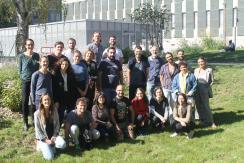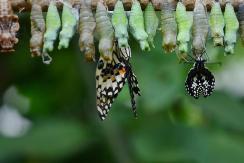COEVOL Multi-Scale Coevolution
Living systems are highly integrated, with a multitude of levels of organization, from molecular and intra-cellular scales to ecosystems. Complex organisms are themselves consortia of macro- and micro-organisms, which work together with their host to build the individual. Yet, each of these organisms can function and evolve in the short term according to its own logic, possibly in conflict with other higher or lower levels, or with other time scales. The once common idea among evolutionists that natural selection results in organisms perfectly adapted to their environment is now severely undermined. Not only because, as the Red Queen explains to Alice, one has to run relentlessly to keep its place in a changing environment, or because past evolutionary history and chance constrain the possibilities of present adaptation, but also because different levels of selection have interests that are generally difficult to reconcile.
Multi-scale coevolution resets classical questions in evolutionary biology
One example, of particular interest is the question of the source of heritable variations. The phenotype of organisms in a population is influenced not only by variations in their nuclear and mitochondrial genomes, the dynamics of which is the object of population genetics, but also more and more patently by the consortium of microbes and genetic elements that constitute its microbiome and virome. The hologenome designates this complex assembly of genetic materials, which obey different rules of transmission and different evolutionary strategies. The ability of symbionts to manipulate host phenotypes or to interfere with each other influences the evolutionary dynamics of all players in ways that are yet poorly understood. In addition, new questions arise, such as the importance of co-adaptation in these systems and their consequences in maintaining cohesive biological systems.
- Symbiosis: a response to and a source of divergent selection
Using a variety of approaches combining experimental evolution, genomic, functional, phenotypic and behavioral data, we aim to test whether symbiosis facilitates diversification and to characterize the underlying microevolutionary processes.
- Ecological networks of horizontal gene transfer
We develop original methods to detect gene transfer and we investigate the factors that influence the routes of gene transfers among microbes but also among insects.
- The interplay between symbiosis, infection and immunity and its evolutionary consequences
We try to understand the intimate interaction of hosts with pathogens, symbionts and transposable elements and how it affects the extended phenotype of the host.
- Transgenerational inheritance and environment changes
We try to decipher the molecular mechanisms that underlie rapid adaptation to environment and to test for transgenerational inheritance of fitness traits.
- Intragenomic conflicts and demography
We are developing models to test whether changes in the demography of the host affect the dynamics of transposable elements.
- The determinism of phenotypic convergence
We study the genomic basis of convergent phenotypic evolution in particular in the case of animals and plants adaptation to increasing temperature and decreasing water.
- Reconciling the tree of life
We develop phylogenetic methods for “reconciling” gene/species or host/symbiont histories and use these methods to explore the bulk of extinct or undescribed species and the history of association of symbiotic microbes with their hosts.
Integrating methods
The methods we use to tackle the questions raised by multi-scale co-evolution extend from theory, modelling and simulation to big data analysis, lab (notably on insects), and to a lesser extent, field activities.
Implication of research, responsibility of researchers and citizen sciences
From our research (some of which have immediate consequences in health, agriculture and ecology) and our concerns about the responsibility of scientists in society, we are committed to promote an “implicative” research. The implicative position means that we try to work on the link between science and society, not only through a one-way communication, applying or explaining our science, but also favoring early discussions on research projects, that may influence our research directions.
Publications
Display of 691 to 709 publications on 709 in total
Physiological cost induced by the maternally-transmitted endosymbiont Wolbachia in the Drosophila parasitoid Leptopilina heterotoma
Parasitology . 121 : 493-500
Journal article
see the publicationAdaptive signi. cance of a circadian clock: temporal segregation of activities reduces intrinsic competitive inferiority in Drosophila parasitoids
The Royal Society . 267 : 1005-1010
Journal article
see the publicationDeficiency mapping of quantitative trait loci affecting longevity in Drosophila melanogaster
Genetics . 156 : 1129-1146
Journal article
see the publicationModifications of the sex pheromonal communication of Trichogramma brassicae by a sublethal dose of deltamethrin
Chemosphere . 38 : 729-739
Journal article
see the publicationWake up of transposable elements following Drosophila simulans worldwide colonization
Molecular Biology and Evolution . 16 ( 9 ) : 1251-1255
Journal article
see the publicationTransposable elements and genome evolution: the case of Drosophila simulans
Genetica . 107 : 113-120
Journal article
see the publicationPhylogenetic evidence for horizontal transmission of Wolbachia in host-parasitoid associations
Molecular Biology and Evolution . 16 : 1711-1723
Journal article
see the publicationPhylogenetic status of a fecundity-enhancing Wolbachia that does not induce thelytoky in Trichogramma
Insect Molecular Biology . 8 : 67-72
Journal article
see the publicationSublethal effects of the insecticide chlorpyrifos on the sex pheromonal communication of Trichogramma brassicae
Chemosphere . 36 : 1775-1785
Journal article
see the publicationA temperature cline in copy number for 412 but not roo/B104 retrotransposons in populations of Drosophila simulans
Proceedings of the Royal Society B: Biological Sciences . 265 ( 1402 ) : 1161-1165
Journal article
see the publicationAccumulation of transposable elements in the heterochromatin and on the Y chromosome of Drosophila simulans and Drosophila melanogaster
Journal of Molecular Evolution . 46 : 661-668
Journal article
see the publicationInhibition of sex pheromone communications of Trichogramma Brassicae (Hymenoptera) by the insecticide chlorpyrifos
Environmental Toxicology and Chemistry . 17(6) : 1107-1113
Journal article
see the publicationTransposable element distribution in Drosophila
Genetics . 147 : 1997-1999
Journal article
see the publicationTransposition rate of the 412 retrotransposable element is independent of copy number in natural populations of Drosophila simulans
Molecular Biology and Evolution . 14 : 185-188
Journal article
see the publicationMaintenance of transposable element copy number in natural populations of Drosophila melanogaster and D-simulans
Genetica . 100 : 161-166
Journal article
see the publicationChromosomal distribution of the 412 retrotransposon in natural populations of Drosophila simulans
Heredity . 79 : 128-134
Journal article
see the publicationGeographical variation in insertion site number of retrotransposon 412 in Drosophila simulans
Journal of Molecular Evolution . 42 : 443-451
Journal article
see the publicationSelection against transposable elements in D-simulans and D-melanogaster
Genetical Research . 68 : 9-15
Journal article
see the publicationComportement de rétrotransposons (copia mdg1 gypsy et 412) dans les populations de Drosophila melanogaster et D. simulans
incollection . -- : 313-325
Journal article
see the publication

